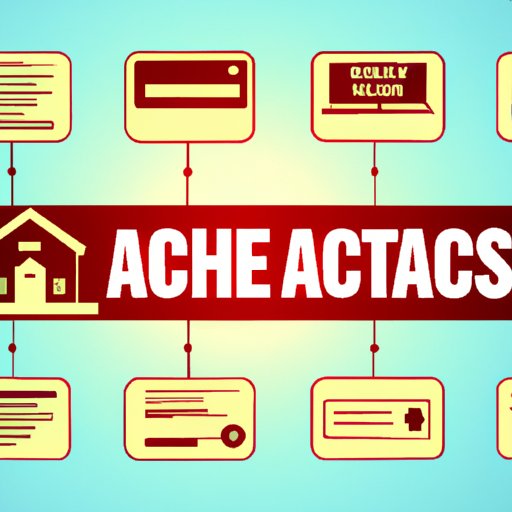Introduction
The Automated Clearing House (ACH) is an electronic network for financial transactions in the United States. It’s used to process direct deposits and bill payments, among other types of payments. ACH payments are becoming increasingly popular for their convenience, security, and cost-effectiveness. In this article, we’ll take a look at what ACH payments are, how they work, and the advantages and risks associated with them.

A Guide to Understanding Automated Clearing House Transactions
An ACH payment is an electronic transfer of funds from one bank account to another. The two accounts must be located in the United States. ACH transactions are initiated by the sender, who provides the required information to their bank. The information is then sent to the receiving bank, which processes the payment and transfers the funds to the receiving account.
There are two types of ACH payments: direct deposits and ACH transfers. Direct deposits are used to deposit funds into a recipient’s bank account, such as payroll or government benefits. ACH transfers are used to send funds from one individual to another, such as when paying bills online or sending money to friends and family.
Advantages of ACH Payments
One of the main advantages of ACH payments is improved security and efficiency. All ACH payments are processed electronically, so there’s no need to worry about lost or stolen checks. Plus, ACH payments are generally faster than paper checks, meaning funds can be transferred quickly and securely.
Another advantage of ACH payments is lower fees and faster processing times. Many banks charge a flat fee for ACH payments, which is usually much lower than the cost of a paper check. Plus, since ACH payments are processed electronically, they can be completed in a matter of minutes, instead of days.

Risks Associated with ACH Payments
Although ACH payments offer many benefits, there are also some potential risks associated with them. One of the biggest risks is potential for fraud or error. Since ACH payments are processed electronically, it’s important to double-check all information before submitting an ACH payment. This includes verifying the recipient’s name, address, and bank account number.
Another risk associated with ACH payments is lack of recourse in case of disputes. If a dispute arises, the sender may not have legal recourse, as they do with paper checks. For this reason, it’s important to research the recipient thoroughly before sending an ACH payment.
Comprehensive Overview of ACH Payments
If you’re interested in using ACH payments, here’s a step-by-step guide to setting them up:
- Check with your bank to see if they offer ACH payments.
- Provide your bank with the necessary information, including the recipient’s name, address, and bank account number.
- Verify that the information is correct before submitting the payment.
- Once the payment is submitted, the funds should be transferred within a few days.
If you decide to terminate your ACH payments, here are some steps you should take:
- Notify the recipient that you’re terminating the ACH payment.
- Contact your bank and request to cancel the ACH payment.
- If the payment has already been processed, contact the recipient to arrange for a refund.

Explaining the Process for ACH Payments
When an ACH payment is initiated, the sender provides the necessary information to their bank. The bank then sends the information to the receiving bank, which verifies the information and processes the payment. Once the payment is processed, the funds are transferred from the sender’s account to the recipient’s account.
To minimize the risk of fraud or errors during an ACH transaction, it’s important to double-check all information before submitting the payment. This includes verifying the recipient’s name, address, and bank account number. It’s also important to research the recipient thoroughly before sending an ACH payment, as there is limited recourse in case of a dispute.
Conclusion
In conclusion, ACH payments are a secure and efficient way to make digital payments. They offer many advantages, such as improved security, lower fees, and faster processing times. However, there are also some potential risks associated with them, such as potential for fraud or error and lack of recourse in case of disputes. With these tips in mind, you’ll be well on your way to making successful ACH payments.
(Note: Is this article not meeting your expectations? Do you have knowledge or insights to share? Unlock new opportunities and expand your reach by joining our authors team. Click Registration to join us and share your expertise with our readers.)
